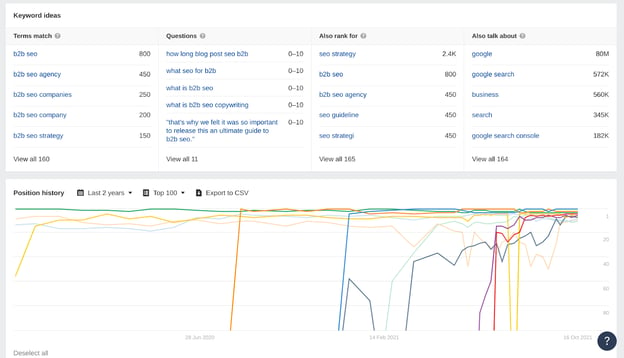
Once you’ve built an asset you want to maintain it and ensure it continues to bring in a return. Too often in SEO, we create high-performing content, and we just expect it to keep bringing in traffic without doing any maintenance on it.
The world changes, and it’s natural that your content will slip down the rankings with time. With a content refresh, you can give your best pages an extra injection of energy, helping them to climb back up the rankings.
1. Why Refresh Old Content?
The reasons behind a content refresh are simple - things change, and often quickly.
The way people search changes, Google’s algorithms change, and the subject you’re writing about changes. This may be a slow change that takes place over a few years, or it could be a very quick change. Either way, if you’ve got old content, then it risks losing relevance.
Because the world is constantly changing, Google values fresh content. It might not be the most important ranking factor, but freshness does play a part in how well your pages rank. This makes sense because no matter what your subject is, there’s always new information coming to light.
It’s not only Google that values freshness either. When you see a page that’s over five years old, and another that’s just a couple of months old, which one are you more likely to click? People want up-to-date information, and content refreshes are a way to make sure you’re providing this.
2. Ten Point Content Refresh Checklist
Refreshing your old content can have a big impact on your SEO. You’ve already invested in creating this content, so you need to make sure you’re protecting your investment by keeping it fresh.
Here are ten steps you can follow to keep your content up-to-date.
Prioritize User Experience
User experience is massive in modern SEO. If your page isn’t appealing to users, then it’s simply not going to rank.
Check the following factors and make sure your page is performing well:
- Page load speed
- Core web vitals
- Readability (are you breaking up your paragraphs into easy-to-read sections?)
- Easy navigation around your website
These are issues that can cause people to leave your page before they even begin to consume your content, so they have to be a key focus.
Check for Errors
Things like spelling and grammar might not be Google ranking factors, but they do play a role in SEO. If your content is riddled with small errors, then it’s going to call into question your authority, and the reader picks up on this.
Sometimes small errors do get through your editorial process, but content refreshes are an excellent opportunity to catch them and make sure your content is perfect. This will improve the user experience and add greater weight to your content.
Improve Accuracy
You can improve the accuracy of your content in a few different ways:
- Accuracy of your titles - do they succinctly sum up the article, incorporate your target keyword, and demand the reader’s attention?
- Accuracy of your meta descriptions - you’ve got limited space to earn someone’s click, is your meta description drawing people to your content?
- Accuracy of your content - can the information in your content be improved upon (remember, to get to the top of the search results, you’ve got to offer the best information)?
This part might take a little bit of time, but it’s still an easier process than creating a brand new article, and it can have a similar impact on your traffic.
Remove Broken Links
Internal and external links are an important part of your content. They allow your readers to dig deeper into the subject and add authority to what you’re saying. Over time, these links can become broken though, and this can be a source of frustration for your users.
Not only are you sending your users on a wild goose chase, but Google also follows the links to non-existent pages, and this can hurt your authority.
 Link to New, Better Resources
Link to New, Better Resources
The world changes quickly, and new blogs and other resources are being published every day. Your content refresh is an opportunity to make sure you’re making use of the latest information and drawing on the best resources.
If the information on your page is no longer relevant, then update it and use new, authoritative sources to back up what you’re saying.
As time goes by, you will also have more of your own blogs to link to, so you may find some good new internal linking opportunities.
Update Your Target and Halo Keywords
People don’t necessarily continue to search in the same ways. They use different phrases to search, and these can gain or lose volume over time. For example, in recent years, searches in the form of questions have become much more common because more people are using voice search.

Do your keyword research and find out whether you need to change your target keyword, and reformat your content accordingly. It’s also helpful to find 3-5 halo keywords (supplementary keywords) you can add to your text.
Follow SEO Best Practice
SEO best practice changes from time to time. Even if it hasn’t there might be small details you missed the first time around.
Make sure to reacquaint yourself with Google ranking factors from time to time and double-check you’re ticking off all the requirements with your content refreshes.
Add Multimedia
A great way to refresh your content is to add new elements to it. Your users don’t necessarily want to read text, they may prefer other options like watching a video or looking at an infographic.
If you can turn your information into an easy-to-consume video or infographic, then it can boost engagement and have an impact on your SEO. Not everyone consumes information in the same way, so try and accommodate more people by adding multimedia.
Build On Thin Content
How many words does it take to offer your readers value? The chances are it’s going to be at least 500 words, and it’s generally accepted that anything under this number is thin content. Thin content is going to struggle to rank because other pages address the subject in more detail.
One of the best things to do is look at the top five results for your target keyword and see how long those pages are. This will give you a good idea of what Google expects, allowing you to update your content accordingly.
Focus on the Goal
Do you know what your content is trying to achieve?
Where does it fit in the customer journey, and what action does it encourage people to take?
If you can’t answer these questions, then you need to think about the goal of your piece of content. SEO isn’t just about getting traffic, it’s about getting that traffic to take action, and all your content should be geared to make this happen.
Bonus Tip: Add Contextual Call to Action Buttons
We focus a lot on getting traffic, but ultimately, SEO is about outcomes.
It’s about getting people to take the actions you want them to take, and to do this, you’ve got to use calls to action well. Once you’ve evaluated the goals of your page, you should look to add contextual calls to action to highlight the steps you want people to take.

Studies continue to show that CTA’s make a tangible difference to your conversion rate. For example, this study looked at personalizing CTA’s to the pages they’re on and found it boosted conversion by 24%.
That’s a massive impact just for tweaking a CTA.
The right call to action can have a big impact on your conversion rate, and it’s a simple aspect to optimize.
3. Conclusion
Performing content refreshes is a great use of your time and resources. Rather than starting from scratch with a new piece of content, it allows you to improve on the articles you already have and make sure they’re bringing in as much traffic as possible.
With a content refresh checklist, you can quickly go through all your old articles and optimize them for maximum SEO impact.
As always, if you want expert advice on the best way to refresh your content and improve your B2B SEO, then get in touch with one of our experts today.




